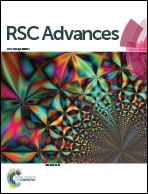l-Cysteine-induced chiroptical activity in assemblies of gold nanorods and its use in ultrasensitive detection of copper ions†
Abstract
Herein we demonstrated a simple and effective strategy to produce plasmonic optical activity in non-chiral assemblies of gold nanorods (GNRs) via adsorption of L-cysteine (L-Cys). Furthermore, by making use of the catalytic role of Cu2+ in the oxidation of L-Cys by dissolved oxygen, the plasmonic CD intensity can be tuned and used for the detection of copper ions. A dynamic detection range is achieved between 10 pM to 10 nM with a limit of detection (LOD) of 2.6 pM. This strategy offers a simple and ultrasensitive detection of Cu2+ in aqueous solution.


 Please wait while we load your content...
Please wait while we load your content...